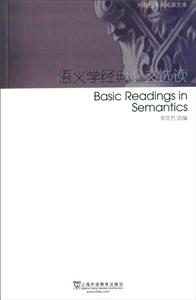-
>
妙相梵容
-
>
基立爾蒙文:蒙文
-
>
我的石頭記
-
>
心靈元氣社
-
>
女性生存戰(zhàn)爭
-
>
縣中的孩子 中國縣域教育生態(tài)
-
>
(精)人類的明天(八品)
語義學(xué)經(jīng)典論文選讀 版權(quán)信息
- ISBN:9787544638166
- 條形碼:9787544638166 ; 978-7-5446-3816-6
- 裝幀:一般膠版紙
- 冊數(shù):暫無
- 重量:暫無
- 所屬分類:>
語義學(xué)經(jīng)典論文選讀 內(nèi)容簡介
《語義學(xué)經(jīng)典論文選讀》選編了語言哲學(xué)、形式語義學(xué)、語用學(xué)和認(rèn)知語義學(xué)領(lǐng)域內(nèi)的20篇經(jīng)典論文, 其中不乏弗雷格、羅素、斯特勞森、格萊斯、萊文森等大家的奠基之作。閱讀這些經(jīng)典的篇章, 不僅有助于我們掌握語言學(xué)學(xué)科的基礎(chǔ)理論知識, 為以后深入研究打好基本功, 而且對提高
語義學(xué)經(jīng)典論文選讀 目錄
**部分:語言哲學(xué)
導(dǎo)讀
Gottlob Frege:On Sense and Reference
Bertrand Russell:Descriptions
Pefer F.Strawson:On Referring
Keith S.Donnellan:Reference and Definite Descriptions
Saul K.Kripke:Naming and Necessity:Lecture Ⅱ
第二部分:形式語義學(xué)
導(dǎo)讀
Donald Davidson:Truth and Meaning
Donald Davidson:The Logical Form of Action Sentences
David Kaplan:On the Logic of Demonstratives
Irene Helm:File Change Semantics and the Familiarity Theory of Definiteness
David Lewis:Scorekeeping in a Language Game
第三部分:語用學(xué)
導(dǎo)讀
H.P.Grice:Logic and Conversation
Francois Recanati:The Pragmatics of What is Said
Laurence R.Horn:Toward a New Taxonomy for Pragmatic Inference:Q—based and R—based Implicature
Stephen C.Levinson:Three Levels of Meaning
Irene Helm:On the Projection Problem for Presuppositions
第四部分:認(rèn)知語義學(xué)
導(dǎo)讀
Dirk Geeraerts:Prospects and Problems of Prototype Theory
George Lakoff:The Contemporary Theory of Metaphor
William Croft:The Role of Domains in the Interpretation of Metaphors and Metonymies
Charles Fillmore:Frame Semantics
Michael Tomasello:First Steps toward a Usage—based Theory of Language Acquisition
語義學(xué)經(jīng)典論文選讀 節(jié)選
《外教社學(xué)術(shù)閱讀文庫:語義學(xué)經(jīng)典論文選讀》: But to my knowledge they have not previously been cultivated to meet the standards for logical and semantical theories which currently prevsil.In particular, Strawson's distinction between the significance (meaningfulness) of a sentence and the statement (proposition) which is expressed in a given use is clearly related.Strawson recognizes that such sentences as 'The present King of France is now bald' may express different propositions in different utterances, and he identifies the meaningfulness of the sentence with its potential for expressing a true or false proposition in some possible utterance.Though he does not explicitly discuss the meaning of the sentence, it is clear that he would not identify such a meaning with any of the propositions expressed by particular utterances.Unfortunately Strawson seems to regard the fact that sentences containing demonstratives can be used to express different propositions as immunizing such sentences against treatment by 'the logician'. In order to convince myself that it is possible to carry out a consistent analysis of the semantics of demonstratives along the above lines, I have attempted to carry through the program for a version of first order predicate logic.The result is the following Logic of Demonstratives. If my views are correct, the introduction of demonstratives into intensional logics will require more extensive reformulation than was thought to be the case. THE LOGIC OF DEMONSTRATIVES The Language LD is based on first-order predicate logic with identity and descriptions.We deviate slightly from standard formulations in using two sorts of variables, one sort for positions and a second sort for individuals other than positions (hereafter called simply 'individuals'). Primitive Symbols for Two Sorted Predicate Logic 0.Punctuation:( ) 1.(ⅰ) An infinite set of individual variables:Vi (ⅱ) An infinite set of position variables:Vp 2.(ⅰ) An infinite number of m-n-place predicates, for all natural numbers m, n (ⅱ) The 1-0-place predicate:Exist (ⅲ) The 1-1-place predicate:Located. ……
- >
唐代進(jìn)士錄
- >
月亮與六便士
- >
羅庸西南聯(lián)大授課錄
- >
伯納黛特,你要去哪(2021新版)
- >
煙與鏡
- >
姑媽的寶刀
- >
朝聞道
- >
莉莉和章魚


















